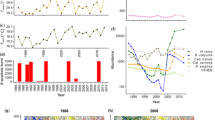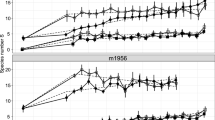Summary
A body of anecdotal and experimental evidence raises questions about the common model of plant community succession, in which each temporal vegetation stage facilitates the development of the next stage. Several lines of evidence are discussed which emphasize the individualistic, independent nature of plant community development:
-
1)
There are a number of instances of anamolous behaviour of ‘pioneer’ or ‘early successional’ species;
-
2)
In shallow marshes, vegetational change is the result of the interaction between the stored ‘seed bank’ of the the ecosystem and the fluctuating water regime;
-
3)
On abandoned coal spolis, vegetational composition and structure are almost entirely accounted for by substrate conditions rather than age differences of the spoils;
-
4)
In overgrazed natural grasslands, adjacent to ungrazed areas, revegetation is primarily by vegetative reproduction of the native species creeping in from the edge as a whole vegetation complex, rather than seeding throughout in stages.
Therefore, plant succession can be interpreted as an individualistic result of the interaction of disturbance (both kind and severity) and the predominant reproductive life histories of the plant species.
It is suggested that future research efferts to understand vegetational change should be directed to the interactions between seed dynamics, asexual/sexual life histories, and microsite environmental variation.
Similar content being viewed by others
References
Anderson, R.C. & D.E. Adams. 1978. Species replacement patterns in central illinois white oak forests. In: P.E. Pope (ed.), Cent. Hardwood Forest conf. II Proc. p. 284–301.
Brotherson, J.D. 1969. Species composition, distribution, and phytosociology of Kalsow Prairie, a mesic tall-grass prairie in Iowa. Ph. D. dissertation, Iowa State Univ. 196 pp.
Brotherson, J.D. & R.Q. Landers. 1979. Recovery from severe grazing in an Iowa tall-grass prairie. In: D.C. Glonn-Lewin and R.Q. Landers (eds.), Proc. Fifth Midwest Prairie Conf. p. 51–56.
Cahayla-Wynne, R. & D.C.Glenn-Lewin. 1978. The forest vegetation of the Driftless area, Northeast Iowa. Amer. Midl. Nat. 100: 307–319.
Chadwick, M.J. & K.M.Hardiman. 1976. Vegetating colliery spoil. In: Papers of the Land Reclamation Conference, pp. 421–42, Grays, Thurrock Borough Council.
Connell, J.H. & R.O.Slatyer. 1977. Mechanisms of succession in natural communities and their role in community stability and organization. Amer. Nat. 111: 1119–1144.
Drury, W.H. & I.C.T.Nisbit. 1973. Succession. J. Arnold Arboretum Harvard Univ. 54: 331–368.
Gleen-Lewin, D.C. 1978. Natural revegetation of acid coal spoils in southeast Iowa. In: M.K. Wali (ed.), Proc. 1st Internat. Cong. Energy and the Ecosystem. (in press).
Jonescu, M.E. 1978. Natural revegetation of strip mined land in the lignite coal fields of southeastern Saskatchewan. In: M.K. Wali (ed.), Proc. 1st Internat. Cong. Energy and the Ecosystem. (in press).
Matthews, J.A. 1979. A study of the variability of some successional and elimax plant assemblage-types using multiple discriminant analysis. J. Ecol. 67: 255–272.
Olson, J.S. 1958. Rates of succession and soil changes on southern Lake Michigan sand dunes. Bot. Gazette 119: 125–170.
Robertson, P.A., G.T.Weaver & J.A.Cavanaugh, 1978. Vegetation and tree species patterns near the northern terminus of the southern floodplain forest. Ecol. Monogr. 48: 240–267.
Simpson, E.H. 1949. Measurement of diversity. Nature 163: 688.
Sørensen, T.A. 1948. A method of establishing groups of equal amplitude in plant sociology based on similarity of species content, and its application to analyses of the vegetation on Danish commons. K. Danske Vidensk. Selsk. Biol. Skr. 5: 1–34.
Steel, R.G.D. & J.H.Torrie 1960. Principles and procedures of statistics. McGraw-Hill, N.Y. 481 pp.
Valk, A.van der & C.B.Davis 1978. The role of seed banks in the vegetation dynamics of prairio glacial marshes. Ecology 59: 322–335.
Walker, D. 1970. Direction and rate in some British post-glacial hydroseres. In: D.Walker & R.G.West (eds.), Studies in the vegetational history of the British Isles, Cambridge Univ. Press, London. p. 117–139.
Author information
Authors and Affiliations
Additional information
I thank Jon White, Maryanne Beach, Roger Landers, Arnold van der Valk, Robert Whittaker, Robert Peet, and Mike Chadwick for their ideas and discussions. Jon White participated in the Kalsow Prairie field work.
Rights and permissions
About this article
Cite this article
Clenn-Lewin, D.C. The individualistic nature of plant community development. Vegetatio 43, 141–146 (1980). https://doi.org/10.1007/BF00121026
Accepted:
Issue Date:
DOI: https://doi.org/10.1007/BF00121026




